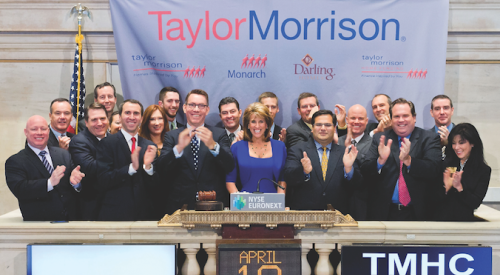The proposed Lennar-U.S. Home merger recently held a mirror to the issue of low stock valuations for public home builders.
Before the deal was announced, U.S. Home’s stock price was about $24. Lennar offered a $12-per-share premium and brought U.S. Home’s share price up to $34 in the market. (The deal could close for $2 per share less, based on fluctuations in the price of Lennar shares, which are being offered to U.S. Home stockholders.) Though $12 is a large per-share premium, at $36, U.S. Home is still agreeing to sell at only 84% of the firm’s book value, a substantial discount dictated by punishing market forces. Thus, the proposed merger is notable not only for the size and stature of the participants, but also because it goes against the recent downward trend of acquisitions because of the low valuations.
But Lennar and U.S. Home officials are bullish about the merger for several reasons, including immediately improved earnings. But none is more important than the merged company’s plan to aggressively foster e-commerce and "last mile" initiatives with Heimbinder serving as executive vice president of e-commerce initiatives.
The general idea, says Heimbinder, is to help innovate the industry through the use of today’s technology the way other industries have done. Rather than seeking to become dot-com companies, builders can show the investment community that the industry is getting up to speed in the new economy. And later it then can be argued that valuations over the long term deserve improvement, adds Zelman.
"If you just think about raw-material costs, builders can save something in the 1% to 3% range on raw materials through better purchasing, through transactions on the Internet," says Zelman. She sees a trend toward back-office connectivity in the industry, led by Lennar and others and facilitated by companies such as BuildNet. "Probably the biggest thing that will help builders is not only the elimination of paper through the system and costs for administration, but the ability to do more of a just-in-time type of process at the construction site."
Lennar will also be active on a business-to-consumer level, says Heimbinder. He thinks "last mile" initiatives will further emerge as a way to increase contact with home buyers and to enhance the experience in the process. "Last mile" refers to the utility connections controlled by builders and developers in new home communities. The idea is to create ongoing business with home buyers by leveraging the opportunities associated with owning telephone and broadband rights-of-way. The Internet in general could also raise customer satisfaction by providing home buyers with the opportunity to view pictures of their homes under construction and later use that Web site to help them find furniture and other new home needs.
"It may sound grandiose, but there is a potential of creating a customer for life," says Heimbinder. "They still are dealing with you on some regular basis, whether it is that you sold them cable in the past, or you sold them security, or every now and then you provide special offers from businesses in the area."
All of this is expected to become an area of earnings growth that in the end might help smooth out some of the cyclical bumps that have traditionally hurt builders and their market perception, says Heimbinder. "One of the reasons why the economy has been so good without inflation is because of technology-spurred productivity gains. E-commerce efficiencies will definitely improve the way things are being done."
Also See:
Out of Whack on Wall Street
D.R. Horton Inc. to Invest $100M in Internet VC Fund
Wall Street Overlooks Demographic Strength












